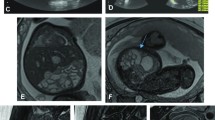Abstract
The technical quality of prenatal US and fetal MRI has significantly improved during the last decade and allows an accurate diagnosis of bowel pathology prenatally. Accurate diagnosis of bowel pathology in utero is important for parental counseling and postnatal management. It is essential to recognize the US presentation of bowel pathology in the fetus in order to refer the patient for further evaluation or follow-up. Fetal MRI has been shown to offer some advantages over US for specific bowel abnormalities. In this paper, we review the normal appearance of the fetal bowel on US and MRI as well as the typical presentations of bowel pathologies. We discuss more specifically the importance of recognizing on fetal MRI the abnormalities of size and T1-weighted signal of the meconium-filled distal bowel.




Similar content being viewed by others
References
Brugger PC, Prayer D (2006) Fetal abdominal magnetic resonance imaging. Eur J Radiol 57:278–293
Huisman TA, Kellenberger CJ (2008) MR imaging characteristics of the normal fetal gastrointestinal tract and abdomen. Eur J Radiol 65:170–181
Hertzberg BS (1994) Sonography of the fetal gastrointestinal tract: anatomic variants, diagnostic pitfalls, and abnormalities. AJR 162:1175–1182
Hill BJ, Joe BN, Qayyum A (2005) Supplemental value of MRI in fetal abdominal disease detected on prenatal sonography: preliminary experience. AJR 184:993–998
Garel C, Dreux S, Philippe-Chomette P (2006) Contribution of fetal magnetic resonance imaging and amniotic fluid digestive enzyme assays to the evaluation of gastro-intestinal tract abnormalities. Ultrasound Obstet Gynecol 28:282–291
Benachi A, Sonigo P, Jouannic JM (2001) Determination of the anatomical location of an antenatal intestinal occlusion by magnetic resonance imaging. Ultrasound Obstet Gynecol 18:163–165
Kesrouani AK, Guibourdenche J, Muller F (2003) Etiology and outcome of fetal echogenic bowel. Ten years of experience. Fetal Diagn Ther 18:240–246
Nyberg DA, Dubinsky T, Resta RG (1993) Echogenic fetal bowel during the second trimester: clinical importance. Radiology 188:527–531
Grignon A, Dubois J, Ouellet MC (1997) Echogenic dilated bowel loops before 21 weeks’ gestation: a new entity. AJR 168:833–837
Nyberg DA, Resta RG, Mahony BS et al (1993) Fetal hyperechogenic bowel and Down’s syndrome. Ultrasound Obstet Gynecol 3:330–333
Colombani M, Ferry M, Garel C et al (2010) Fetal gastrointestinal MRI: all that glitters in T1 is not necessarily colon. Pediatr Radiol 40:1215–1221
Zizka J, Elias P, Hodik K et al (2006) Liver, meconium, haemorrhage: the value of T1-weighted images in fetal MRI. Pediatr Radiol 36:792–801
Deroches A, Galerne D, Baudon J (1974) Biochemical composition of meconium (carbohydrates, lipids, proteins and related substances). J Gynecol Obstet Biol Reprod (Paris) 3:543–552, In French
Zalel Y, Perlitz Y, Gamzu R (2003) In utero development of the fetal colon and rectum: sonographic evaluation. Ultrasound Obstet Gynecol 21:161–164
Veyrac C, Couture A, Saguintaah M (2004) MRI of fetal GI tract abnormalities. Abdom Imaging 29:411–420
Ramón y Cajal CL, Martínez RO (2003) Defecation in utero: a physiologic fetal function. Am J Obstet Gynecol 188:153–156
Saguintaah M, Couture L, Veyrac C (2002) MRI of the fetal gastrointestinal tract. Pediatr Radiol 32:395–404
Shinmoto H, Kuribayashi S (2003) MRI of fetal abdominal abnormalities. Abdom Imaging 28:877–886
Rubesova E, Vance CJ, Ringertz HG (2009) Three-dimensional MRI volumetric measurements of the normal fetal colon. AJR 192:761–765
Munch EM, Cisek LJ Jr, Roth DR (2009) Magnetic resonance imaging for prenatal diagnosis of multisystem disease: megacystis microcolon intestinal hypoperistalsis syndrome. Urology 74:592–594
Ghi T, Tani G, Carletti A (2005) Transient bowel ischaemia of the fetus. Fetal Diagn Ther 20:54–57
Farhataziz N, Engels JE, Ramus RM (2005) Fetal MRI of urine and meconium by gestational age for the diagnosis of genitourinary and gastrointestinal abnormalities. AJR 184:1891–1897
Lubusky M, Prochazka M, Dhaifalah I (2006) Fetal enterolithiasis: prenatal sonographic and MRI diagnosis in two cases of urorectal septum malformation (URSM) sequence. Prenat Diagn 26:345–349
Colombani M, Ferry M, Toga C (2010) Magnetic resonance imaging in the prenatal diagnosis of congenital diarrhea. Ultrasound Obstet Gynecol 35:560–565
Husu S, Nelson N, Selbing A (2001) Prenatal bowel dilatation: congenital chloride diarrhoea. Arch Dis Child Fetal Neonatal 85:F65
Höglund P, Sormaala M, Haila S (2001) Identification of seven novel mutations including the first two genomic rearrangements in SLC26A3 mutated in congenital chloride diarrhea. Hum Mutat 18:233–242
Orlowski J, Grinstein S (2004) Diversity of the mammalian sodium/proton exchanger SLC9 gene family. Pfluger Arch 447:549–565
Kim SH, Kim SH (2001) Congenital chloride diarrhea: antenatal ultrasonographic findings in siblings. J Ultrasound Med 20:1133–1136
Tsukimori K, Nakanami N, Wake N et al (2007) Prenatal sonographic findings and biochemical assessment of amniotic fluid in a fetus with congenital chloride diarrhea. J Ultrasound Med 26:1805–1807
Disclaimer
The supplement this article is part of is not sponsored by the industry. Dr. Rubesova has no financial interest, investigational or off-label uses to disclose.




